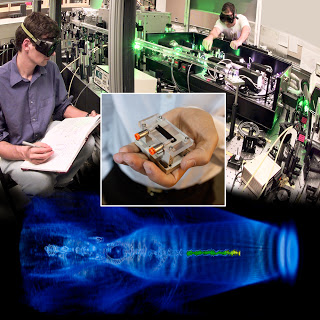The rapidly evolving technology of laser plasma accelerators (LPAs) – called “table-top accelerators” because their length can be measured in centimeters instead of kilometers – promises a new breed of machines, far less expensive and with far less impact on the land and the environment than today’s conventional accelerators.
Future LPAs offer not only compact high-energy colliders for fundamental physics but diminutive light sources as well. These will probe chemical reactions, from artificial photosynthesis to “green catalysis”; unique biological structures, inaccessible to other forms of microscopy yet essential to understanding life and health; and new materials, including low-temperature superconductors, topological insulators, spintronics devices, and graphene nanostructures, which will revolutionize the electronics industry. With intensely bright beams spanning the spectrum from microwaves to gamma rays, table-top accelerators will open new vistas of science.
LOASIS has produced well-formed electron beams of up to a billion electron volts in laser plasma accelerators just 3.3 centimeters long. A typical laser set-up is shown above, with the billion-electron-volt accelerating module in the inset. Below, a laser wakefield accelerates a pulse of electrons (bright yellow and green) in this simulation by Cameron Geddes. (Photos Roy Kaltschmidt, Lawrence Berkeley National Laboratory)
X-ray spectroscopy is used to obtain single-shot information on electron beam emittance in a low-energy-spread 0.5 GeV-class laser-plasma accelerator. Measurements of betatron radiation from 2 to 20 keV used a CCD and single-photon counting techniques. By matching x-ray spectra to betatron radiation models, the electron bunch radius inside the plasma is estimated to be ∼0.1 μm. Combining this with simultaneous electron spectra, normalized transverse emittance is estimated to be as low as 0.1 mm mrad, consistent with three-dimensional particle-in-cell simulations. Correlations of the bunch radius with electron beam parameters are presented.
If you liked this article, please give it a quick review on ycombinator or StumbleUpon. Thanks

Brian Wang is a Futurist Thought Leader and a popular Science blogger with 1 million readers per month. His blog Nextbigfuture.com is ranked #1 Science News Blog. It covers many disruptive technology and trends including Space, Robotics, Artificial Intelligence, Medicine, Anti-aging Biotechnology, and Nanotechnology.
Known for identifying cutting edge technologies, he is currently a Co-Founder of a startup and fundraiser for high potential early-stage companies. He is the Head of Research for Allocations for deep technology investments and an Angel Investor at Space Angels.
A frequent speaker at corporations, he has been a TEDx speaker, a Singularity University speaker and guest at numerous interviews for radio and podcasts. He is open to public speaking and advising engagements.




